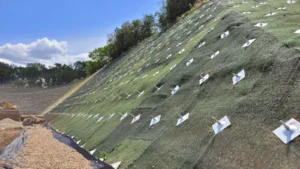Introduction
Deep foundation support systems are crucial for the stability and safety of high-rise buildings. These systems serve as temporary structures during the initial phases of construction, providing essential support to the building’s foundation while ensuring safety during the excavation and load-bearing stages. The construction of deep foundations is intricately tied to the development of underground infrastructure, such as pipelines and roads, and the overall foundation construction. Due to the complexity of geological conditions and the critical nature of these structures, deep foundation support requires precise design, careful execution, and rigorous safety protocols.
However, several technical challenges arise during the construction of deep foundation systems in high-rise buildings. These difficulties can impact the safety, stability, and cost-effectiveness of the construction project. This article explores the common issues encountered in the construction of deep foundation support systems and offers insight into best practices for overcoming these challenges.
1. Structural Design Challenges in Deep Foundation Support
The Importance of Structural Design in Foundation Support
The safety of the deep foundation support structure is paramount in ensuring the overall stability of high-rise buildings. Inadequate foundation support can lead to catastrophic failures that jeopardize both the building and the surrounding infrastructure. One of the primary concerns in the design of deep foundation support structures is ensuring that the soil pressure and other environmental factors are thoroughly considered.
The design process is complicated by the complex geological conditions typically encountered in urban construction projects. Soil composition, groundwater levels, and underlying bedrock structures vary significantly across the construction site, making it difficult to predict and model the foundation’s behavior under load. Accurate soil parameters, such as water content, internal friction angle, and shear strength, are essential for calculating the required support structure dimensions and strength. However, these parameters are often difficult to determine precisely, leading to increased uncertainty in the design.
The Role of Soil Parameters in Design
Soil parameters play a pivotal role in determining the performance of the foundation. For instance, high water content can reduce the shear strength of soil, affecting the foundation’s load-bearing capacity. The internal friction angle, which is a measure of the soil’s resistance to sliding, is another key parameter that must be accurately assessed. Misjudging these values can lead to suboptimal designs, which can affect both safety and cost-efficiency.
In many cases, due to the variability of soil conditions, engineers must rely on conservative estimates or perform extensive site investigations to better understand the ground conditions before finalizing their designs. This adds significant time and cost to the project, highlighting the inherent complexity of deep foundation design for high-rise buildings.
2. Challenges in Confirming the Quality of Foundation Soil
The Issue of Inconsistent Soil Data
One of the most common challenges in deep foundation construction is determining the quality of the foundation soil. Soil testing, often performed through sampling, is typically used to gather data on the soil’s composition, strength, and other properties. However, this approach may not fully reflect the variability of soil conditions across a large construction site, especially for high-rise buildings, where the footprint of the building may span a significant area.
The problem arises because soil sampling typically involves taking a limited number of samples from various points within the site. While this can provide valuable insights into the general composition of the soil, it may fail to capture localized variations or anomalies that could impact the design of the deep foundation support. If the soil at certain points differs significantly from what was anticipated based on the samples, it could lead to inadequate support design, potentially compromising the stability of the building.
Addressing Inconsistent Soil Data
To mitigate the risks associated with inconsistent soil data, engineers and construction teams should adopt more advanced methods for soil investigation. These methods include the use of geophysical surveys, in-situ testing, and advanced modeling techniques that provide a more comprehensive view of the soil conditions across the entire construction site. By incorporating a wider range of data and employing more sophisticated tools, construction teams can improve the accuracy of their foundation designs and avoid issues caused by soil variability.
3. The Impact of Excavation Space Effects
Horizontal Displacement and Its Consequences
During the excavation process for deep foundations, construction teams often face challenges related to horizontal displacement, particularly the inward movement of the foundation’s sides. This phenomenon occurs when the excavation process disrupts the soil surrounding the foundation, causing it to shift inward. As a result, the middle of the foundation may become larger than the sides, which can lead to instability in the foundation structure.
This “space effect” can reduce the stability of the side slopes of the excavation, which in turn affects the integrity of the foundation. If the soil surrounding the foundation becomes too unstable, it may lead to settlements or shifting, which could compromise the safety of the building and its foundation system.
Mitigating Excavation Space Effects
To mitigate the risks posed by excavation space effects, construction teams should implement effective excavation support systems, such as shoring, soil nailing, or bracing. These techniques help stabilize the excavation and prevent unwanted soil movement. Additionally, excavation work should be carried out in phases, with careful monitoring of soil movement during each phase. Using advanced monitoring equipment, such as inclinometers and settlement gauges, can provide real-time data on soil movement and allow for timely interventions to prevent further instability.
4. Deficiencies in Force Calculations and Their Impact
Limitations of the Limit Equilibrium Method
Another challenge encountered in the design of deep foundation support structures is the reliance on the limit equilibrium theory for force calculations. This method, while widely used, has certain limitations when applied to high-rise building projects. The limit equilibrium theory is used to determine the safety factor of the foundation support structure by calculating the forces acting on it. It helps ensure that the foundation will not fail under the expected loads, but it may not fully capture the complexity of real-world soil behavior and other dynamic factors.
While the limit equilibrium method is effective in ensuring safety, it can lead to overestimation of the required support strength, resulting in higher construction costs. The conservative nature of this approach may also result in over-designed foundations that are more expensive and less efficient than necessary.
Exploring Alternative Calculation Methods
To address the deficiencies of the limit equilibrium method, engineers are increasingly turning to more advanced methods, such as numerical modeling and finite element analysis. These approaches allow for a more detailed analysis of the forces acting on the foundation support structure, accounting for dynamic soil behavior, water pressures, and other factors. By using these advanced tools, engineers can optimize the design of the deep foundation support system, ensuring that it is both safe and cost-effective.
Conclusion
The construction of deep foundation support systems for high-rise buildings presents several technical challenges that require careful planning, design, and execution. From the complexities of structural design and soil quality assessment to issues related to excavation space effects and force calculations, each aspect of deep foundation construction demands close attention to detail. Addressing these challenges requires a combination of advanced technology, thorough site investigations, and experienced engineers who understand the nuances of the construction process. If you have any needs, you can also read the article Application of Construction Technologies for Deep Foundation Support for more details.
By staying informed about the latest developments in foundation design, adopting advanced techniques, and ensuring that proper safety protocols are in place, construction teams can overcome these challenges and deliver high-rise buildings that are safe, stable, and built to last.





